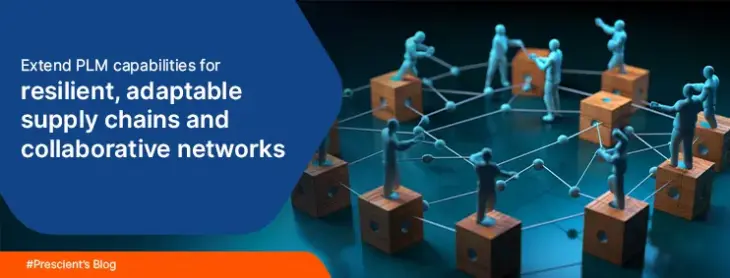Extend PLM capabilities for resilient, adaptable supply chains and collaborative networks
- Home
- Blog Details

- October 19 2025
- systemadmin
Have you ever had to halt production because a critical supplier failed to deliver on time? Many manufacturers struggle with broken links in the supply chain, especially when their digital tools can’t adapt fast enough. In today’s uncertain environment, it’s no longer enough to have a Product Lifecycle Management (PLM) system that just tracks internal workflows. You need one that connects, adapts, and responds across your entire supply network.
This is where PLM customization helps. It extends the core capabilities of your PLM system to create resilient, adaptable supply chains and collaborative ecosystems across suppliers, design teams, and manufacturing partners.
Why Standard PLM Isn’t Enough for Modern Supply Chains
Traditional PLM systems are mostly built to serve internal engineering teams. They focus on managing product data, revisions, and approvals. But supply chains today involve global partners, suppliers, and external contributors. Static systems can’t handle this complexity.
PLM needs to evolve from being a data repository to becoming a connected collaboration backbone. That transformation begins with customisation.
How PLM Customization Supports Supply Chain Resilience
1. Design for Disruption
Disruptions be it a pandemic, conflict, or material shortage can break traditional supply chains. Companies with custom PLM workflows can build alternative sourcing models and simulate supply risks before they cause damage.
A customised PLM system can:
- Map supplier dependencies across geographies
- Tag alternate part options for critical components
- Trigger sourcing workflows if lead times increase
According to Wired (2023), 75% of manufacturers plan to invest in digital resilience tools after recent global supply chain shocks.
2. Real-Time Supplier Collaboration
Your suppliers shouldn’t be left out of your product lifecycle. A customised PLM platform can offer secure access to selected data, letting vendors contribute at earlier stages of design and manufacturing.
Key features include:
- Role-based access to BOMs and 3D models
- Document upload and compliance tracking
- Workflow triggers for part approval and feedback
With PLM supplier collaboration, you reduce cycle time and improve component quality before a part reaches production.
3. Faster Workflows with Automation
Manual approvals and data updates often cause delays. PLM workflow automation streamlines repetitive tasks by automatically routing files, notifying users, and logging changes.
Common use cases include:
- Auto-triggering compliance reviews for new designs
- Notifying suppliers of design changes instantly
- Closing engineering change orders after final approval
This level of automation brings greater control and reduces human error.
TechVersions reports that PLM automation can cut product development time by up to 35% (2024).
Connecting the Digital Thread Beyond the Organisation
The digital thread is the flow of data that connects every stage of your product lifecycle. PLM is a core part of this, but without customization, the thread often breaks when external partners come into play.
PLM customization helps by:
- Integrating with ERP, MES, and supplier platforms
- Maintaining a single source of truth across systems
- Enabling visibility across design, sourcing, and production
By building an extended thread, you ensure that everyone internal or external is working from the same up-to-date product data.
Why Adaptability Needs to Be Built Into PLM
Resilience is not just about reacting to crises it’s about adapting quickly. An adaptable PLM system allows you to:
- Modify workflows as your supply strategy changes
- Introduce new approval gates for new partners
- Track compliance with local regulations in multiple regions
This flexibility makes it easier to meet customer demands, enter new markets, and respond to emerging challenges without rebuilding your system from scratch.
Signs You Should Extend Your PLM Capabilities
You might need PLM customization if:
- Your suppliers rely on email for updates
- You struggle to trace changes made by external contributors
- Workflow bottlenecks slow down your sourcing processes
- Product delays often trace back to communication gaps
- You plan to expand your supplier base or sourcing strategy
These issues become business risks as supply chains get more complex. A generic PLM setup cannot handle such variability. A customised one can.
What Prescient Technologies Offers
Prescient Technologies helps manufacturers build smarter PLM environments that go beyond engineering silos. We specialise in:
- PLM customization for supply chain collaboration
- PLM workflow automation tailored to your process
- Integration with ERP and MES for connected decision-making
- Cloud-ready PLM extensions for real-time supplier engagement
- Scalable access control and compliance features
Our team has delivered custom PLM solutions for leading global manufacturers across industries, making their product and supply data more connected, secure, and adaptable.
Key Takeaways
- A traditional PLM setup is no longer enough in today’s volatile supply chain environment.
- Customising your PLM allows you to collaborate better with suppliers and adapt to disruptions.
- Workflow automation, digital thread integration, and role-based access can significantly improve agility and speed.
- Cloud integration ensures global teams and vendors stay aligned in real-time.
Ready to Extend Your PLM Capabilities?
If your organisation is looking to improve product visibility, strengthen supplier networks, and build more adaptable operations, it’s time to extend your PLM system.
👉 Talk to Prescient Technologies about how PLM customization can make your supply chain more resilient, collaborative, and future-ready.
Contact us to get started.
- systemadminhttps://www.pre-scient.com/author/systemadmin/
- systemadminhttps://www.pre-scient.com/author/systemadmin/
- systemadminhttps://www.pre-scient.com/author/systemadmin/
- systemadminhttps://www.pre-scient.com/author/systemadmin/

